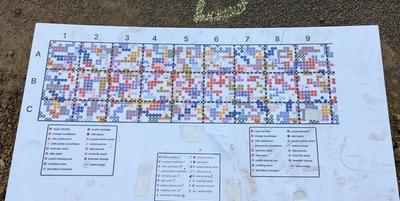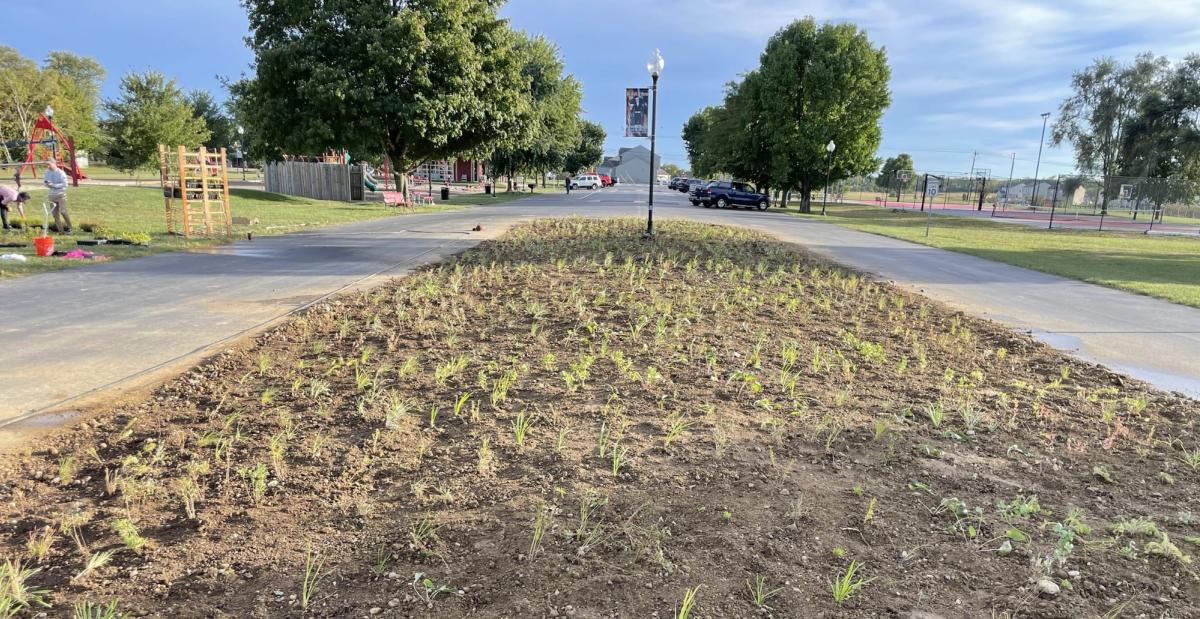Native Plants for Replacing Grass in Municipal Landscapes

Native plants and grasses are inexpensive to install and are low-maintenance and require little to no additional water.
In August the My Home Park team got a request from the Mayor of South Bloomfield, OH, to fix a very challenging problem of dead sod leading up to the new village hall. The entryway of the new village hall, home to the largest flag in the county, had a 200’ long strip of land that was bothering residents with an unsightly look of dry and dead grass.

The maintenance team gave up their sod revival efforts as the grass was continuously drinking up gallons of water without showing any signs of life. The strip is in an open area with constant exposure to strong winds. The mayor was given a budget of $4 per square foot and asked to find a better alternative to grass for covering up the large patch that welcomes visitors and employees. More importantly, they needed a solution that was low-maintenance and did not require watering.
During a search, the mayor connected with My Home Park. He saw an opportunity to replace the grass with native plants that will bloom beautiful colors, serve as a haven for pollinators and require almost no maintenance or extra water. My Home Park was up for the task and the results are amazing, and the project was completed in 4 weeks from order to planting.

Creating a Native Plant Landscape Design- From Concept to Execution
David and Wyatt, the co-founders of My Home Park, came up with a custom design plan using plants that are ecologically adapted to thrive in the weather and soil conditions of Columbus, OH. They followed the philosophy of a good native plant design by replicating the different components of natural wildlife habitat.
Design Philosophy
Here are some of their design considerations:
- Include perennials that have different bloom times to fill the gardening patch with a rainbow of colors all around the year. The selection process of perennials involved certain aspects like height, bloom cycle and colors. Once planted, perennials last for many years and effortlessly maintain the area's beauty with minimal care.
- Use low-maintenance native plants that are drought-tolerant, disease-resistant and resilient to the hot, dry and windy environment
- Space plants closely to crowd out weeds and cover up bare patches of the earth with lush green foliage
- Maintain plant diversity to increase pollinator visits and create welcoming habitats for a variety of insects, birds and small animals
- Plant in drifts and layers to mimic the natural layers of a forest. Layered planting offers a great visual interest to the landscape by adding layers of textures, colors and patterns
- Use native ground covers instead of sod to fill up empty spaces with pretty foliage and seasonal blooms. Ground covers also have a great price advantage compared to sod and eliminate maintenance expenses
Here is what their final design of 5000 native plants looked like once planted:

Here is what we expect the site to look like in 18 months:

David and Wyatt created a life-size blueprint using flags to indicate the areas where each variety of native plants will get planted. This layout proved helpful for people with no prior gardening experience to install the native plant plugs in the designated spots in just 3 days. Since native plants are accustomed to their natural habitats, it won’t be long before they successfully establish themselves in the area and transform the entire look of the walkway.
My Home Park would like to thank Mayor Matthew Pettibone for trusting us with your village hall landscape and giving us an opportunity to create an aesthetically pleasing and environmentally sensible project. We take great pride in installing one of the largest native plant gardens in Ohio that can feed millions of pollinators while serving as a beautiful native plant entryway for your village hall.

Share this article


